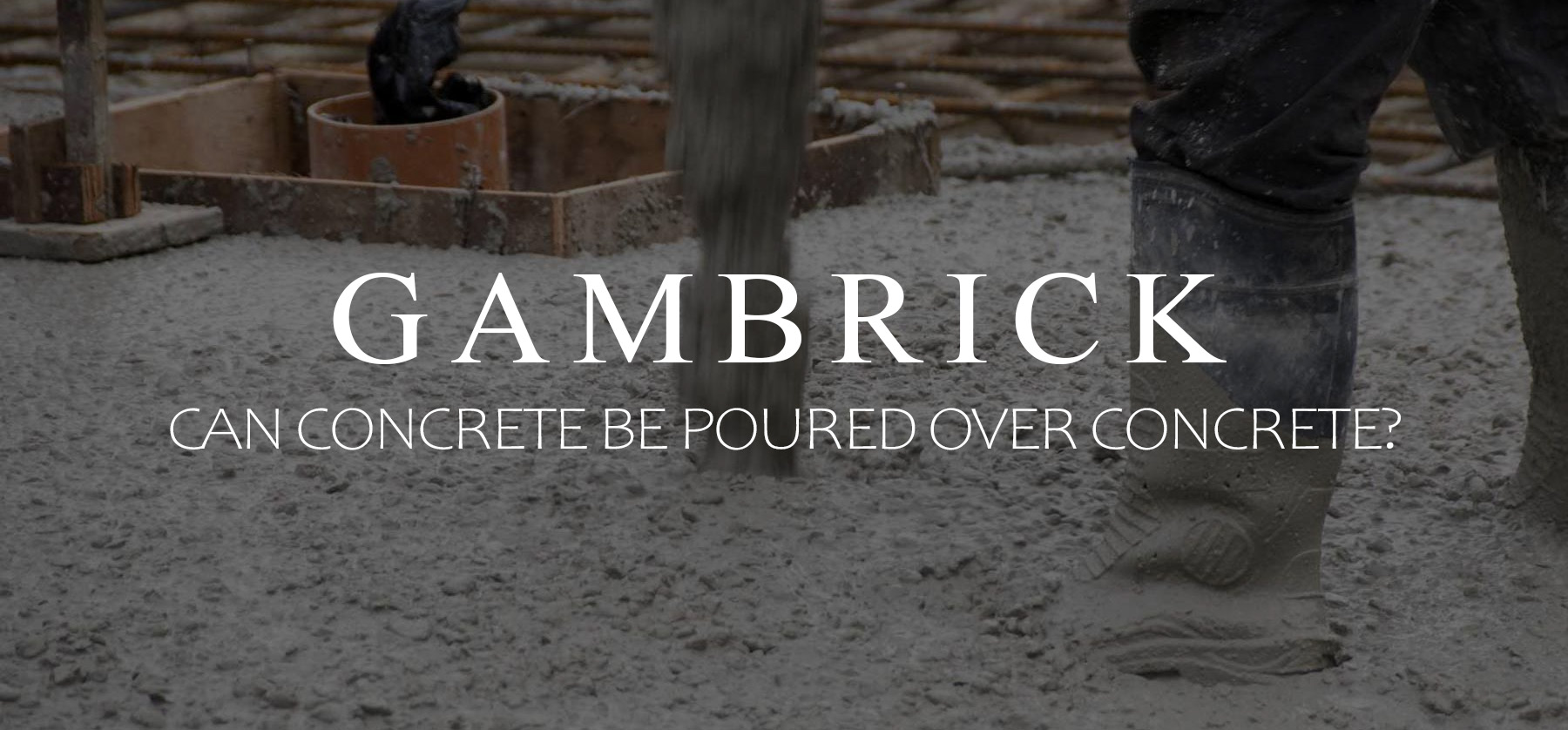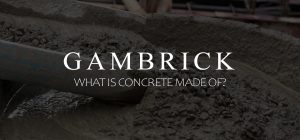
Can Concrete Be Poured Over Concrete?
New concrete can be poured over old concrete as long as the old slab is in good condition and the new slab is at least 2 inches thick. But I’ve been a mason for over 25 years and can tell you firsthand that issues with your old concrete slab, such as cracks, will effect the new concrete on top if you don’t fix them. Always repair the older slab first so the new concrete has a strong and secure base.
Concrete doesn’t stick to other materials very well, so to bond concrete to concrete you need a good quality bonding agent. Apply the agent to the existing concrete before pouring new concrete on top. Without the bonding agent, you’ll have two slabs sitting atop each other, but they won’t stick together.
The new slab has to be at least 2 inches thick because thin concrete is prone to cracking. Even though you’re pouring concrete on top of concrete, the slabs are independent, not one big slab. The fresh concrete will crack if it’s not thick enough or supported properly.
Inspect the old concrete first. If it’s cracked, heaved or settling, fix those issues before pouring new concrete on top. If you pour new concrete without fixing the existing problems first, they’ll most likely happen again.
Structurally sound concrete with some minor cracks and/or a worn, pitted or aged surface, is generally OK to pour fresh concrete on top of.
Make sure the old concrete is clean and free of paints or sealants before pouring new concrete on top. Foreign substances will make it harder for the fresh concrete to bind with the old slab.
Watch your heights. Generally an old concrete slab is set at a specific height because of stairs or doorways. Adding additional concrete will alter this.
Can You Pour New Concrete Over Old Concrete?
You can pour new concrete over old concrete, however, there are a few very important things you need to know first.
- Pouring new concrete over old does not make 1 big slab of concrete. This is why the new concrete has to be at least 2 inches thick. For example, if you pour one inch of fresh concrete over 4 inches of old, you don’t have a 5 inch thick slab. You’ve got a 1 inch slab sitting on top of a 4 inch slab. 1 Inch of concrete is too thin and will crack.
- The old slab is now the base for your new concrete. This is why it must be solid and repaired before you pour the new concrete on top. Any issues with the old slab will effect the new. Especially if it’s heaved, cracked or settling.
- Check your heights. Concrete slabs are typically set at a specific height in relation to doorways and stairs. Adding inches of additional concrete on top will alter these heights and could violate a code.
- I almost always use a bonding agent on the old concrete. This helps the new concrete adhere to the old.
- Clean the old concrete and remove all paints and sealants.
- Use wire mesh and/or rebar to strengthen the new slab.
If you’re able to pour new concrete over old concrete, you should consider some of the pros and cons first. Below are a few cons you may want to consider:
Cons
Just because you can pour new concrete on top of old, doesn’t mean you necessarily should. There are a few cons you should consider first.
- Maintenance: Pouring a new slab of concrete over an old one doesn’t create a single thicker slab. It creates two concrete slabs. This means there is a seam in the middle. Cleaning the surface thoroughly and using a bonding agent helps the new slab adhere to the old, but they’re still two slabs. This means water can sit in the seam and freeze. When you pour new concrete over old, there’s a higher chance of damage due to freezing. To prevent this, be diligent about sealing the concrete and keeping water out.
Frost heaves are typically caused by freezing temperatures and water sitting below the slab. Cold temperatures lift the concrete which can cause cracks. This worse with two slabs because the water can sit below the slab and in between them.
If you spot damage repair it immediately to stop spreading.
- Thinner Concrete: Generally the new concrete slab is thinner than the old one. I usually recommend at least a 4-6 inch of concrete, but that’s probably too thick if you’re going over an existing slab. You’ll probably need just 2-3 inches to make the heights work. Thinner concrete doesn’t hold up as well as thick concrete. Especially outdoors or under heavy loads.
If you demolished the old concrete and replaced it with new, the slab would be thicker and last longer. However, it’s a lot more expensive.
Pouring new concrete over an old slab is a lot cheaper and easier to do, but it doesn’t last as long and requires more maintenance.
Additional Concerns
When you pour fresh concrete on top of an old slab, there are a few things you should pay attention to.
- Height: Be aware of staircases, walkways, doorways and drainage. Concrete is typically set at a specific heights. In some cases because of code requirements. When you add additional height to a slab you also alter these heights. In some cases they may not matter, but at the bottom of a staircase they do. More height can also alter drainage plans so keep this in mind too.
If you add a few inches of concrete to a walkway leading to a driveway or patio, you could create a tripping hazard. The walkway would be inches taller than the slab it connects to. You can fix this by creating a gentle slope, but the concrete would be too thin at the tapered edge. I recommend demolishing a few feet of old walkway where it connects to the slab. This allows for a freshly poured taper.
- Bonding: When you pour new concrete over old, you get two slabs, not one big one. This means a seam between the old and new concrete. Water can sit here and eventually crack the upper, thinner slab. You can prevent this by bonding the two slabs together using a bonding agent. Spread it all over the old concrete prior to pouring the new. Make sure you clean the old concrete and remove sealants and paint first.
It’s important to consider the seam between the two slabs. Seal the upper slab to keep water from penetrating into the seam. Thin slabs are more prone to cracking than thicker ones.
Tips
There are a few tips I’ve learned over the years as a mason that I’ll share with you next.
- Reinforcement: Boding the new slab with the old one is very important. The better the bind, the less likely the new slab is to crack. To help with this, I tie the new reinforcement into the old slab. If I’m using wire mesh for a 2 inch new slab, I first drill holes and cement rebar spikes into the old slab. They stick up about an inch and penetrate into the new slab. I then tie the new wire mesh to these rebar spikes. The fresh 2 inches of concrete not only adhere to the old slab, but also the rebar and wire mesh.
- Drainage: In some cases I drill drainage holes in the old slab. Any water that penetrates into the seam can drain through these holes. However, I only do this when I’m pouring 4 inches or more of new concrete. This is because ground water can move up through the holes and into the seam. The upper slab has to be very strong to resist cracks from water underneath it. I also only do this when the lower slab has good existing drainage and a lower vapor barrier.
- Concrete: I try to use a matching PSI concrete. Concrete that’s too strong can actually crack weaker concrete when it bonds to it.
How To Pour Concrete Over Existing Concrete Step By Step
Here’s a simple to follow step by step guide on how to pour concrete over existing concrete.
Step 1. Clean the old concrete slab. I like to use a pressure washer. Remove as much sealants and paint as possible.
Step 2. Let the concrete dry, then apply a concrete bonding agent. I use a roller and brush and paint it on lightly. The binding agent helps adhere the new concrete to the old.
Step 3. Build the border for your new slab. I like to use 2x4s as forms.
Step 4. Install rebar reinforcement into the old slab if your using them.
Step 5. Install your new slabs reinforcement if you’re using it. Generally this is either rebar or wire mesh.
Step 6. After the forms are set, and all the reinforcement is in place, it’s time to pour concrete. Before I do, I always clean the old slab with a blower. This will remove any dust or dirt that’s built up.
Step 7. After the concrete is poured I start to work it with my float and other concrete tools. Use stamps, colors and other finishes as required.
The tools I use to pour new concrete are:
- A concrete screed
- Concrete rake
- Bull Float
- Mag float
- Shovel
- Extra chute
- Concrete boots
- Concrete gloves
- Masonry hammer
- Hammer drill and bits
- Pliers and wire cutters
- Rebar cutter
- Wood for level stakes
- Leveling equipment. I use a transom and laser or string.
- Water. I always bring water and a way to mist water onto the concrete as I work it.
- Plastic sheeting or concrete blankets if needed.
How Thin Can You Pour Concrete Over Existing Concrete?
The thinnest concrete I’ll pour over old concrete is 2 inches. Any thinner and you’re asking for cracks. In the construction industry we call a 2 inch layer of concrete a dust cap. They’re strong and hold up well as long as the lower slab is in good structural shape and the bond is secure between slabs.
Remember, concrete has different size aggregate rock in it. If you pour thinner than 2 inches you won’t have much cement over and around the aggregate to get strong concrete. It’ll end up cracking and breaking off in flakes if you pour it too thin.
Any thinner than 2 inches would be too thin. When setting the thickness of the new slab, consider where it is. If this is an outside slab, thicker concrete is definitely better because you’ll have water and fluctuating temperatures to deal with. Even in hot climates, temperatures can vary quite a bit from day to night. These concerns aren’t typically an issue when the concrete is indoors.
When Should I Not Add New Concrete Over Old
In some cases, you don’t want to pour new concrete directly on top of old concrete. Below we’ll discuss a few.
- Roots: If the old slab is damaged due to roots, pouring new concrete on top will look good for a while, but will crack again as the roots continue to grow. You need to demo the section of concrete over the root and deal with it. In some cases this means cutting out the root which could kill the tree. However to save the tree, you could pour sand on top of the root and a thinner layer of fresh concrete on top. This provides a few inches of room between the root and concrete slab.
- Height. If the new concrete height would violate building codes, you’ll have no choice but to rip out the old slab.
- Concrete Spalling: Spalling is different than cracks and other forms of structural damage. If the existing slab is breaking down and deteriorating, you shouldn’t pour a new slab on top. The old slab is essentially the base for your new slab. If it’s super weak and brittle, the new concrete could easily crack.
In each of these situations, you should remove the old concrete, resolve the problem, and then pour a new concrete slab. Keep in mind this doesn’t necessarily mean demolishing all the old concrete. In most cases, you can demo just the problem areas and leave the bulk of the old concrete.
How Do You Attach Concrete To Old Concrete?
In most cases you can pour new concrete right on top of old concrete by following the steps we’ve already discussed like removing sealants and paint, repairing damage, using a bonding agent, and cleaning the surface. But in other cases you may want to attach the new concrete slab onto the old one. This involves more than just cleaning and repairs.
No matter what you do, when you pour new concrete on top old concrete, you’ve got two slabs sitting next to each other. Bonding agents and cleaning help the slabs adhere to each other, but there’s still a seam where the slabs can detach. But you can tie them together with reinforcement. This makes slab separation and damage much less likely.
Rebar is short for reinforcing bar, it’s a metal bar used to strengthen and reinforce concrete slabs. In this case, rebar can be used vertically to tie the two slabs together.
The size of the rebar and how many you need depends on the size of the concrete slab. For most residential slabs, like driveways, sidewalks and patios, I use either 1/2 inch or 5/8inch rebar.
Rebar is first installed vertically between the two slabs. Drill holes into the old slab and then bang rebar in. Use anchoring cement to secure the rebar in the hole. The rebar spike should extend to the middle of the new concrete. For example, if you’re pouring 2 inches of fresh concrete, the rebar should stick up just 1 inch from the old slab.
If you’re using reinforcement inside the new concrete slab, like rebar or wire mesh, tie it into the rebar spikes you just installed.
How To Secure Concrete To Concrete Step By Step
Here are the steps you need to follow when securing new concrete with old concrete. Keep in mind, this is after you’ve already repaired damage, cleaned the surface, and removed sealants and paint.
- Drill holes in the old concrete slab 12 – 16 inches on center. I leave about an inch f concrete on the bottom of the hole. For example, if my old concrete slab is 5 inches thick, I drill a 4 inch deep hole.
- Don’t drill holes within 6-8 inches of the edge to prevent chipping.
- Flush water or blow air into the holes to clean them out.
- Inject a little epoxy or anchor cement into the holes.
- Bang rebar into the hole. Use more anchoring cement to seal the gap around the rebar and hole’s edge. Let the cement fully dry.
- Clean the concrete surface again to get rid of concrete dust created by drilling.
- If you’re using a bonding agent, which I strongly recommend, apply it now.
- If your new slab is using reinforcement, install it now. This is typically wire mesh or rebar. Tie the reinforcement to the spikes with twisted wire.
- Pour new concrete over the old.
Can You Stamp & Color New Concrete Over Existing Concrete?
Yes, you can stamp an color fresh concrete poured over old concrete. But the new concrete has to be thick enough to allow for the depression the stamp creates.
When stamping concrete, there are two methods to consider, textured rollers or hand stamps. Both leave a depression in the concrete which creates a design like tiles or rocks.
The depression a stamp creates makes the concrete even thinner and more prone to cracks. For this reason, I recommend adding at least an additional inch of concrete. If you’re pouring 2 inches of concrete over your old concrete but want stamps, add 3 inches instead. This will make the stamped areas much stronger and less prone to cracks.
Color can be added to new concrete no matter how thick it is. It comes in two basic forms.
- You can add color right into the wet concrete mix. This method colors the concrete all the way through. This creates a uniform solid coloring which is generally considered unnatural looking.
- Powdered color can be spread on top of the concrete as it sets. This is only surface color and not all the way through. But this type of color is more natural because it’s not even. You can even use multiple colors in your design.
- Color can be added both to the wet mix and on top as the concrete sets.
Can Concrete Over Concrete Be Resurfaced?
Resurfacing concrete is a great way to make an old concrete slab look new again. And yes, you can resurface concrete that’s on top of concrete. It makes no difference that your new concrete slab has been poured on top of an old one. In the future, as the new concrete gets older and unattractive, you’ll be able to resurface it.
Resourcing old concrete is a great solution for the following:
- Covering unattractive concrete
- Concealing imperfections
- Fixing cracks
- Covering up discoloration
- Changing outdated finishes
Keep in mind, that although resurfacing does make concrete look better, it doesn’t solve any of the underlying issues. If your concrete is starting to lift, crack or settle, resurfacing won’t fix any of those problems.
Can You Pour Concrete Over Painted Concrete?
I recommend removing paint and sealants from an old concrete slab before pouring new concrete on top, but that’s not always possible. If you have to pour new concrete directly on top of painted concrete, you’ll need thicker concrete and possibly reinforcement.
The problem with pouring new concrete onto painted concrete is the bond. Fresh concrete won’t adhere well to the paint, so you need thicker concrete to compensate and possibly some reinforcement.
I always use at least 3 inches of concrete over painted concrete. But for 3 inches I recommend also using some rebar drilled into the old slab and wire mesh. We’ve already gone over how to install this.
For thicker slabs of 4 inches or more, I pour the new concrete right on top of the paint without additional reinforcement. A 4 inch concrete slab is generally strong enough all by itself.
If the concrete is painted and you’re pouring less than 3 inches of new concrete on top of it, you have to remove the paint before pouring or the concrete will crack. The fresh concrete will not be able to bind with the old.
Another big issue is water. Paint is a great sealant and blocks water from penetrating into the old slab. But it will also acts as a blockage for water penetrating through your new slab. The water will sit below your fresh slab and above the paint. This could cause all sorts of damage long term. Especially if this water freezes.
Can You Pour Concrete Over An Existing Concrete Driveway?
Yes, but I recommend using thicker concrete.
A driveway carries a lot more load than a sidewalk or patio because of the cars and trucks driving on top of it. You may also have road salt to deal with which can eat at concrete. Because of this, it’s a good idea to go stronger. The thicker the concrete, the higher the compressive strength it has and the less likely it is to crack.
I recommend using rebar reinforcement stakes to tie the old slab with the new and a bonding agent.
I also recommend using rebar or wire mesh reinforcement inside the new concrete driveway.
Summary: Can Concrete Be Poured Over Concrete?
New concrete can be poured over old concrete as long as the old slab is in good condition and the new slab is at least 2 inches thick. Issues with your old concrete slab, such as cracks, will effect the new concrete on top if you don’t fix them first. Always repair the older slab first so the new concrete has a strong and secure base. The new slab has to be at least 2 inches thick because thin concrete is prone to cracking. The total slab thickness when you’re all done doesn’t matter. Even though you’re pouring concrete on top of concrete, the slabs are independent, not one big slab. The fresh concrete will crack if it’s not thick enough or supported properly.
Inspect the old concrete first. If it’s cracked, heaved or settling, fix those issues before pouring new concrete on top. If you pour new concrete without fixing the problems first, they’ll most likely happen again.
Structurally sound concrete with some minor cracks and/or a worn, pitted or aged surface, is generally OK to pour fresh concrete on top of.
Make sure the old concrete is clean and free of paints or sealants before pouring new concrete on top. The 2 slabs will not fully bond together to create one big slab, but they can adhere to each other if the old concrete is clean and sealant free. Bonding agents can also be used to help adherence.
Wire mesh and/or rebar can also be added to the middle of the new concrete to prevent cracking.
Watch your heights. Adding new concrete over old will change things around doorways and stairs.
If you have any questions or comments about pouring concrete over concrete, Email any time.

John Mazzuca | About | More Posts |
Custom Home Builder
John Mazzuca is a custom home designer and builder at Gambrick with over 25 years experience in the construction industry. John has designed, built and/or remodeled hundreds of homes, small buildings, and commercial projects. He writes about business, real estate, home building, and household electronics. His work has been featured in Fox Business, Better Homes & Garden, House Beautiful, and more.




















